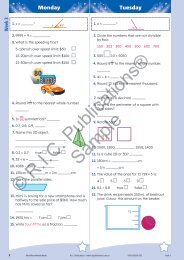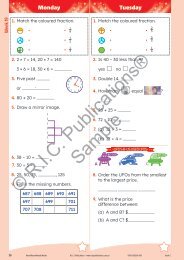20771_Problem_solving_Year_6_Background_information_resources
Create successful ePaper yourself
Turn your PDF publications into a flip-book with our unique Google optimized e-Paper software.
INTRODUCTION<br />
The following problem shows how these<br />
understandings can be used.<br />
A city square has an<br />
area of 160 m 2 . Four small<br />
triangular garden beds are<br />
constructed at from each<br />
corner to the midpoints of<br />
the sides of the square.<br />
What is the area of each<br />
garden bed?<br />
Reading the problem carefully shows that there 4<br />
garden beds and each of them takes up the same<br />
proportions of the whole square. A quick look at the<br />
area of the square shows that there will not be an<br />
exact number of metres along one side. Some further<br />
thinking will be needed to determine the area of each<br />
garden bed.<br />
If the midpoints of each side are drawn across the<br />
square, four smaller squares are formed and each<br />
garden bed takes up 1 4 of a small square. Four of the<br />
garden beds will have the same area of one small<br />
square. Since area of the small square is 1 4 the area of<br />
the large square, the area of one small square is 40 m 2<br />
and the area of each triangular garden bed is 10 m 2 .<br />
An understanding of the problem situation given by a<br />
diagram has been integrated with spatial thinking and<br />
a capacity to calculate mentally with simple fractions<br />
to provide an appropriate solution. Both spatial sense<br />
and number sense have been used to understand the<br />
problem and suggest a means to a solution.<br />
Data sense is an outgrowth of measurement sense<br />
and refers to an understanding of the way number<br />
sense, spatial sense and a sense of measurement<br />
work together to deal with situations where patterns<br />
need to be discerned among data or when likely<br />
outcomes need to be analysed. This can occur among<br />
frequencies in data or possibilities in chance.<br />
Data sense involves:<br />
• understanding how numeration and<br />
computation underpin the analysis of data<br />
• appreciating the relative likelihood of<br />
outcomes<br />
• a capacity to use calculators or mental and<br />
written processes for exact and approximate<br />
calculations<br />
• presenting and interpreting data in tables and<br />
graphs<br />
• an inclination to use understanding and facility<br />
with number combinations and arrangements<br />
in flexible ways.<br />
The following problem shows how these<br />
understandings can be used.<br />
A bag has five blue marbles,<br />
three red marbles and four<br />
yellow marbles. How many<br />
red marbles need to be<br />
added to the bag so that the<br />
probability of drawing a red<br />
marble is 3 4 ?<br />
An understanding of probability and careful analysis of<br />
the situation are needed to come to terms with what<br />
the problem is asking. If the probability of drawing<br />
a red marble is 3 4 , then the probability of drawing<br />
a blue or yellow marble must be 1 4 . There are nine<br />
blue or yellow marbles, so there would need to be 36<br />
marbles altogether to give the probability of 1 4 and<br />
all the other marbles must be red. 27 of the marbles<br />
would have to be red, so another 24 red marbles need<br />
to be added to the bag. A systematic consideration of<br />
the possible outcomes has allowed a solution to be<br />
developed.<br />
Patterning is another critical aspect of sense<br />
making in mathematics. Often a problem calls on<br />
discerning a pattern in the placement of materials,<br />
the numbers involved in the situation or the possible<br />
arrangements of data or outcomes so as to determine<br />
a likely solution. Being able to see patterns is also<br />
very helpful in getting a solution more immediately or<br />
understanding whether or not a solution is complete.<br />
R.I.C. Publications ® www.ricpublications.com.au <strong>Problem</strong>-<strong>solving</strong> in mathematics<br />
xi


















